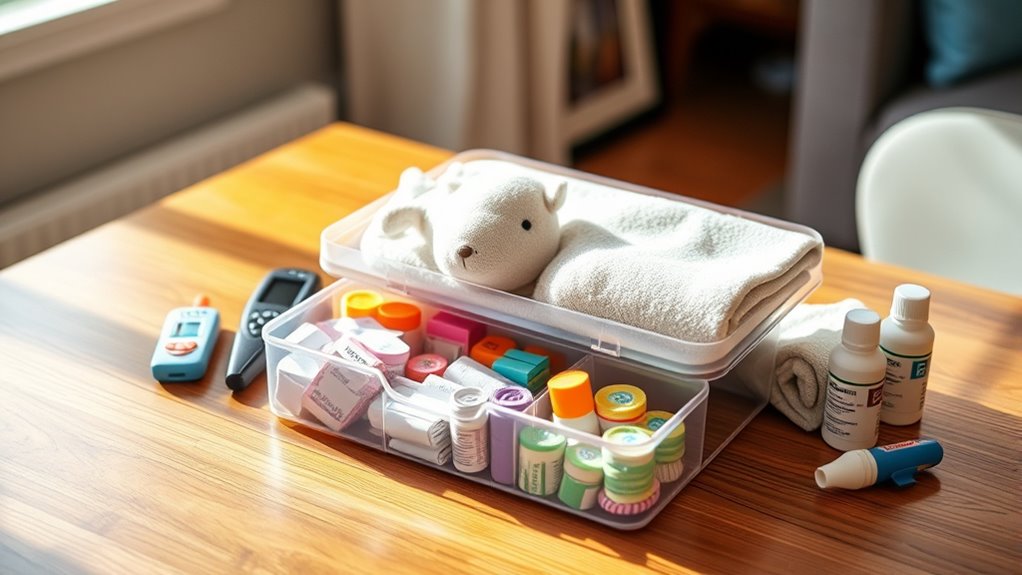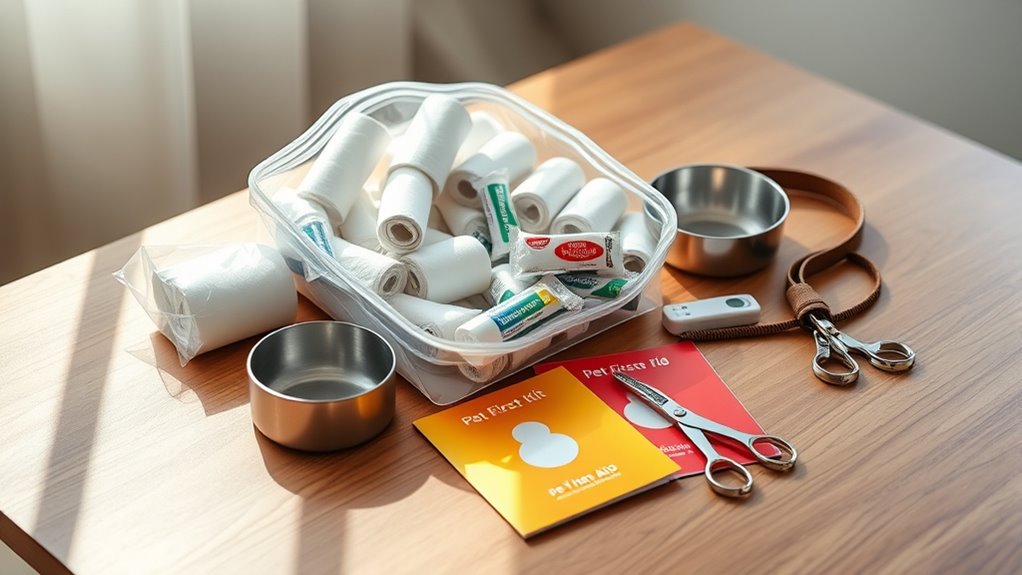To build a thorough pet emergency kit, gather essentials like first aid supplies, including gauze, bandages, antiseptic wipes, and tweezers. Keep your pet’s medical records, medications, vaccination details, and ID tags in a waterproof container nearby. Pack enough food, water, treats, and comfort items such as toys or blankets. Regularly check and update the kit, ensuring everything remains functional and ready for use. If you continue exploring, you’ll learn how to organize and maintain your kit effectively.
Key Takeaways
- Gather first aid supplies like sterile gauze, antiseptic wipes, tweezers, and a digital thermometer for immediate injury care.
- Include updated medical and vaccination records, medications, and any special needs information for quick reference.
- Equip the kit with pet identification items such as current ID tags, microchip details, and recent photos.
- Pack essential pet care items, including food, water, bowls, treats, and comfort toys to reduce stress during emergencies.
- Store supplies in a waterproof container in an accessible location, and regularly check and update the kit’s contents.

Preparing a pet emergency kit is vital for guaranteeing your furry friend’s safety during unexpected situations. When emergencies strike, having the right supplies on hand can make all the difference. One of the first steps is gathering your first aid essentials, which should include items like sterile gauze, adhesive bandages, antiseptic wipes, tweezers, and a digital thermometer. These tools will help you manage minor injuries or stabilize your pet until professional help arrives. It’s also wise to include any medications your pet regularly takes, along with a copy of their medical records. Having these documents easily accessible can be indispensable if you need to seek veterinary care elsewhere or in urgent situations.
Another indispensable component of your emergency kit is pet identification. Ensure your pet always wears a collar with an up-to-date ID tag that displays your current contact information. Consider adding a microchip if your pet isn’t already microchipped—this provides an additional layer of security if your pet gets lost during chaotic moments. Keep a recent photograph of your pet in your kit as well; it can be invaluable if you need to post notices or seek help locating your pet. Including a copy of your pet’s registration, vaccination records, and any special behavioral or medical needs will also simplify the process if you need to find veterinary care quickly.
Ensure your pet wears a current ID tag, consider microchipping, and keep recent photos and medical records for quick help.
Beyond first aid essentials and pet identification, your kit should contain enough supplies to sustain your pet for a few days. Pack food, water, and bowls, along with a manual can opener if your pet’s food requires one. Don’t forget to include treats to keep your pet calm and comfort items like their favorite toy or blanket. These items can help reduce stress during a frightening situation. Additionally, prepare a flashlight, batteries, and a basic toolkit for any emergency repairs or issues that might arise at home or on the go. Being aware of emergency preparedness strategies can improve your response time and effectiveness in critical moments.
Set your kit in a sturdy, waterproof container that’s easy to grab in a hurry. Store it in a designated, accessible place where everyone in your household knows to find it. Regularly check and update your supplies, especially perishables like food and medications. By doing so, you guarantee everything stays fresh and ready to go. Building a comprehensive pet emergency kit isn’t just about being prepared; it’s about giving your pet the best chance of safety and comfort during unpredictable emergencies.
Frequently Asked Questions
How Often Should I Update My Pet Emergency Kit?
You should update your pet emergency kit at least every six months to guarantee kit maintenance and keep your supplies fresh. Regular emergency kit reviews help you spot expired medications, missing items, or changes in your pet’s needs. Additionally, update your kit after any significant life change, such as a new pet or health condition. Staying proactive ensures you’re always prepared for any emergency.
Can I Include Human Medications in My Pet Kit?
You shouldn’t include human medications in your pet emergency kit because of human medication safety concerns. Many human drugs can be toxic to pets, so it’s best to use pet medication alternatives recommended by your vet. If your pet needs medication, always get proper guidance to guarantee safety. Keep your vet’s contact info handy, and avoid risking harm by using human medicines during emergencies.
What Should I Do if My Pet Is Injured During a Disaster?
If your pet is injured during a disaster, act quickly by applying basic first aid techniques like stopping bleeding with pressure or immobilizing broken limbs. Keep calm and carefully move your pet to a safe area. Remember to have emergency contact planning in place, including your veterinarian and local emergency services. Stay with your pet, monitor their condition, and seek professional help as soon as possible to guarantee their safety.
Are There Specific Items for Different Types of Pets?
Pet preparedness requires specific supplies for species and breed. For example, birds need bite-sized treats and cage essentials, while cats benefit from litter and scratching posts. Dogs may need breed-specific items like muzzle or orthopedic bedding. Consider species-specific supplies and breed considerations to guarantee your pet’s safety and comfort during emergencies. Customizing your kit makes sure you meet your pet’s unique needs, minimizing stress and maximizing safety in a crisis.
How Do I Store My Pet Emergency Kit Safely?
To store your pet emergency kit safely, choose a waterproof, durable container in an accessible location, like a closet or garage. Make certain the storage offers safety from pests, extreme temperatures, and accidental spills. Keep the kit easily reachable during emergencies, and regularly check and update supplies. Label the container clearly so anyone can find it quickly, guaranteeing storage safety and kit accessibility when you need it most.
Conclusion
Now that you’ve assembled your pet emergency kit, you’re prepared for unexpected moments. But what if the unthinkable happens when you least expect it? Will your kit have everything your furry friend needs to stay safe and comfortable? Stay vigilant, keep your supplies updated, and never stop planning. Because in a crisis, your quick actions could make all the difference—protecting your pet and giving them hope when they need it most.









